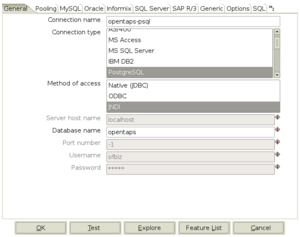Difference between revisions of "Transforming Data with Kettle"
| Line 5: | Line 5: | ||
== Setting up Kettle == | == Setting up Kettle == | ||
| + | If you want to design transformation with Kettle, you have first to setup your databases connections. To do this you have to edit the file simple-jndi/jdbc.properties in the Kettle installation directory. | ||
| − | + | Here is an example on how to setup this file | |
| − | + | <pre> | |
| − | + | opentaps/type=javax.sql.DataSource | |
| + | opentaps/driver=org.postgresql.Driver | ||
| + | opentaps/url=jdbc:postgresql://127.0.0.1/ofbiz | ||
| + | opentaps/user=ofbiz | ||
| + | opentaps/password=ofbiz | ||
| − | + | opentaps_analytics/type=javax.sql.DataSource | |
| + | opentaps_analytics/driver=com.mysql.jdbc.Driver | ||
| + | opentaps_analytics/url=jdbc:mysql://localhost/opentaps_analytics | ||
| + | opentaps_analytics/user=opentaps | ||
| + | opentaps_analytics/password=opentaps | ||
| − | + | opentaps_analytics_testing/type=javax.sql.DataSource | |
| − | + | opentaps_analytics_testing/driver=com.mysql.jdbc.Driver | |
| − | + | opentaps_analytics_testing/url=jdbc:mysql://localhost/opentaps_analytics_testing | |
| + | opentaps_analytics_testing/user=opentaps | ||
| + | opentaps_analytics_testing/password=opentaps | ||
| + | </pre> | ||
== Designing Transformation and Job Templates == | == Designing Transformation and Job Templates == | ||
| Line 26: | Line 38: | ||
### Specify the connection information to opentaps_analytics, our data warehouse. Also ensure characterEncoding of UTF8 in options as above. | ### Specify the connection information to opentaps_analytics, our data warehouse. Also ensure characterEncoding of UTF8 in options as above. | ||
### Test the connection and ensure it works | ### Test the connection and ensure it works | ||
| + | |||
| + | On the right is a screenshot of the way to configure a database. | ||
| + | |||
| + | [[Image:Kettle_database_configuration.png|thumb]] | ||
I have created a kettle template for generating the seed data. You can import this in Spoon and change the database configuration if necessary. That is only if you need to edit the template. | I have created a kettle template for generating the seed data. You can import this in Spoon and change the database configuration if necessary. That is only if you need to edit the template. | ||
| Line 33: | Line 49: | ||
To edit an existing transformation in Spoon, use File > Import from an XML file, and import the file (for example, StoreDimensionTemplate.ktr from analytics/templates/ directory.) When you are done, use File > Export to an XML file to save the transformation as an XML file again, instead of storing it in the database. | To edit an existing transformation in Spoon, use File > Import from an XML file, and import the file (for example, StoreDimensionTemplate.ktr from analytics/templates/ directory.) When you are done, use File > Export to an XML file to save the transformation as an XML file again, instead of storing it in the database. | ||
| − | + | == Debuging a Transformation == | |
| − | + | After clicking on the run button in the menubar, there is an option to activate logs with more or less verbosity. | |
| + | |||
| + | You can use the preview button in the menubar, which let watch the whole result of one step | ||
Revision as of 15:44, 21 May 2008
These are preliminary notes.
Contents
Setting up Kettle
If you want to design transformation with Kettle, you have first to setup your databases connections. To do this you have to edit the file simple-jndi/jdbc.properties in the Kettle installation directory.
Here is an example on how to setup this file
opentaps/type=javax.sql.DataSource opentaps/driver=org.postgresql.Driver opentaps/url=jdbc:postgresql://127.0.0.1/ofbiz opentaps/user=ofbiz opentaps/password=ofbiz opentaps_analytics/type=javax.sql.DataSource opentaps_analytics/driver=com.mysql.jdbc.Driver opentaps_analytics/url=jdbc:mysql://localhost/opentaps_analytics opentaps_analytics/user=opentaps opentaps_analytics/password=opentaps opentaps_analytics_testing/type=javax.sql.DataSource opentaps_analytics_testing/driver=com.mysql.jdbc.Driver opentaps_analytics_testing/url=jdbc:mysql://localhost/opentaps_analytics_testing opentaps_analytics_testing/user=opentaps opentaps_analytics_testing/password=opentaps
Designing Transformation and Job Templates
To create our date dimension seed data using Spoon, the steps are,
- Create a New Transformation using New -> New Transformation
- On the left, you'll see three collapsed sections, Main Tree, Core Objects and Favorite Steps. Expand the Main Tree section.
- Under Transformations right click Database Connections and select New
- Specify the connection information to opentaps_analytics, our data warehouse. Also ensure characterEncoding of UTF8 in options as above.
- Test the connection and ensure it works
- Under Transformations right click Database Connections and select New
On the right is a screenshot of the way to configure a database.
I have created a kettle template for generating the seed data. You can import this in Spoon and change the database configuration if necessary. That is only if you need to edit the template.
Editing a Transformation
To edit an existing transformation in Spoon, use File > Import from an XML file, and import the file (for example, StoreDimensionTemplate.ktr from analytics/templates/ directory.) When you are done, use File > Export to an XML file to save the transformation as an XML file again, instead of storing it in the database.
Debuging a Transformation
After clicking on the run button in the menubar, there is an option to activate logs with more or less verbosity.
You can use the preview button in the menubar, which let watch the whole result of one step
